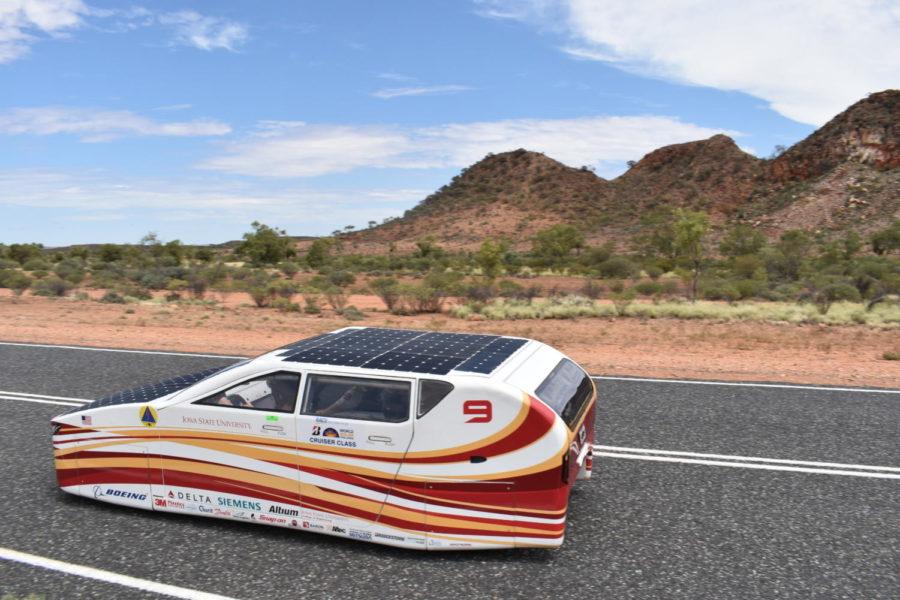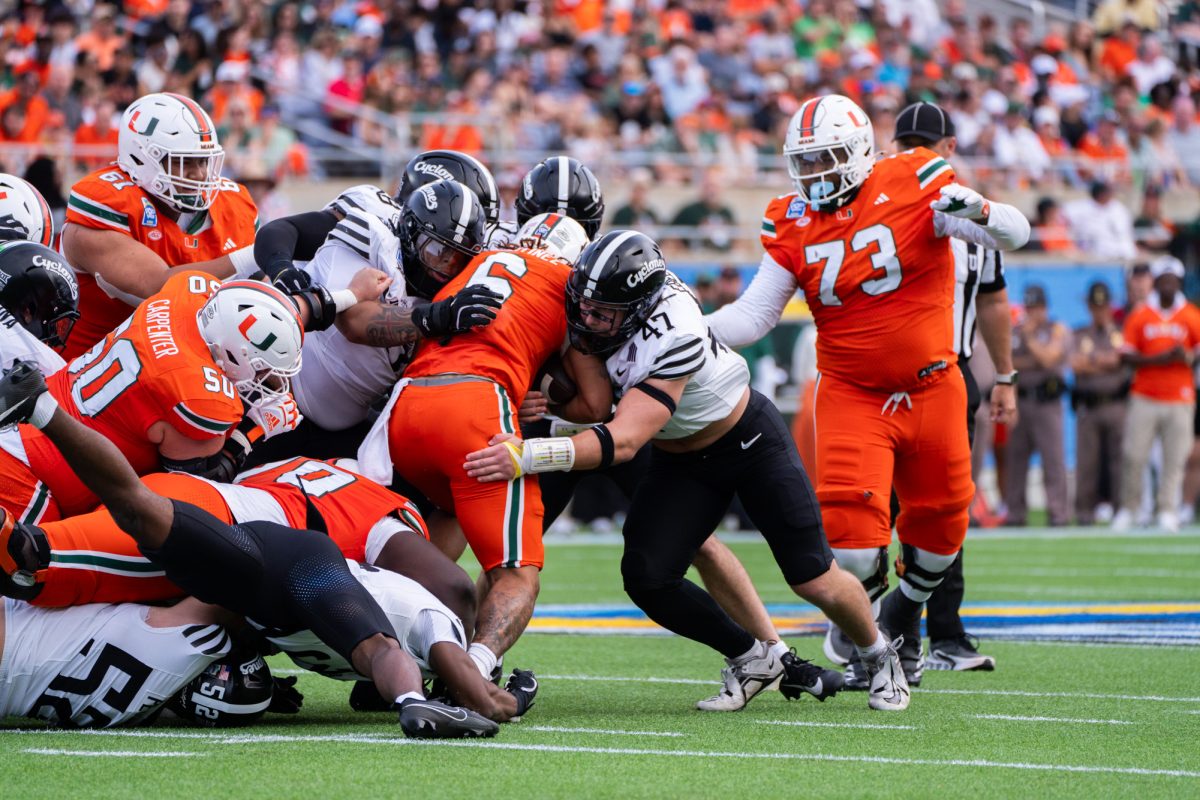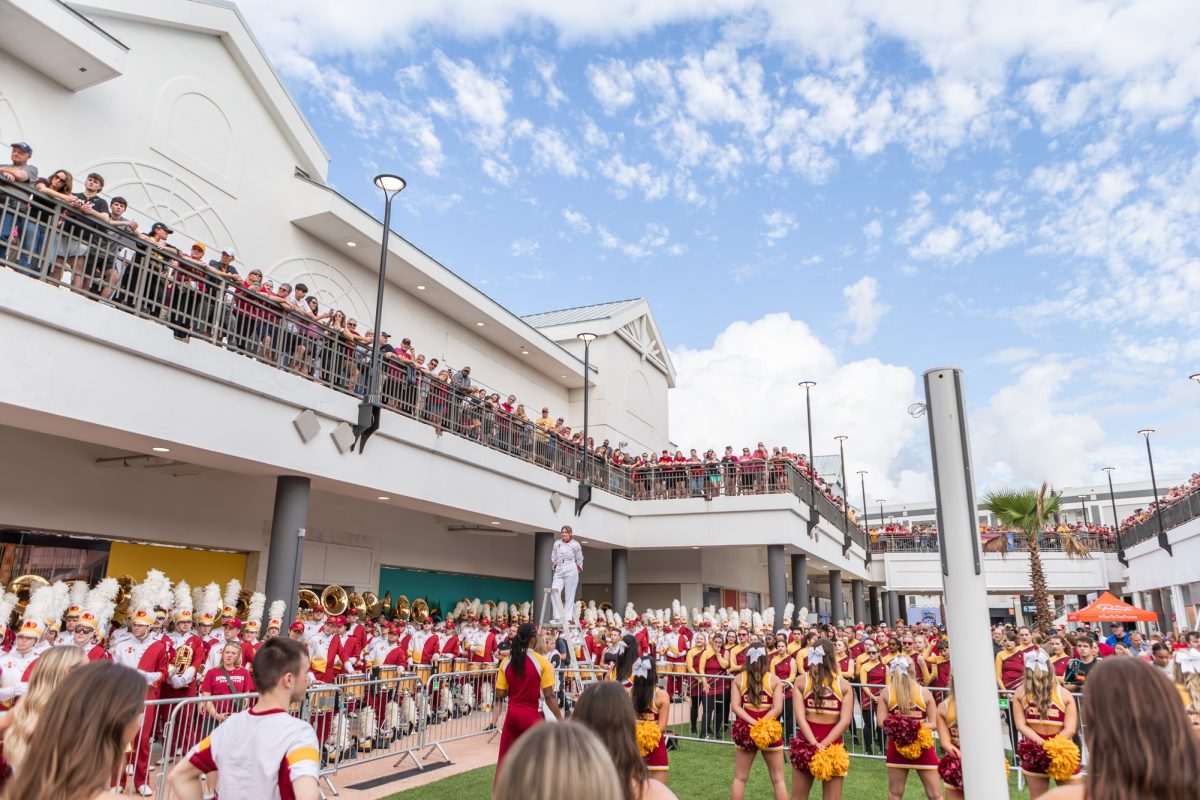PrISUm returns from World Solar Challenge
Courtesy of member Elliot Suiter
PrISUm car Prenumbra driving along route in Australia.
October 31, 2017
The World Solar Challenge (WSC) is a biennial event that sees teams from around the world compete to cross the Australian continent in a solar car, beginning in the Northern Territory of Darwin, and finishing in Adelaide, South Australia.
In total, the race is over 1,800 miles long. Teams have just six days to complete the journey.
Team PrISUm, the ISU solar car team, began their pursuit of the WSC over two years ago. However, their main focus wasn’t to win the competition, but to change how the world looked at solar cars.
“Our goal was to build a practical car,” said Matt Goode, race lead for the 2017 WSC. “We wanted to change the paradigm of transportation with Penumbra. There aren’t many U.S. competitions that highlight the use of a multi-seat car, so we kind of had the vision to build our car and apply for the WSC at the same time.”
Penumbra, PrISUm’s current car, features much more practicality than most other solar cars. It has four doors, four seats, an easily accessible trunk and an on-board touch screen multimedia display that can be found in most newer cars today.
Their car was bigger, less aerodynamic and heavier than most other cars in the competition.
“But it was safer, roomier and had more cargo space,” Goode said. “And that’s what we wanted to achieve with this car.”
One of the biggest things the team had to focus on leading up to and during the competition was communication.
“It was really important for everyone to communicate with each other on what they were doing so that each system works together on the car,” said Andrew Mallek, systems director for the car. “There were also logistical challenges that come with shipping a car across the world, and that proved to be pretty difficult for us and other teams.”
PrISUm partnered with Boeing to have their battery pack flown from the U.S. to Australia. The team had to get a handwritten note from the head of the Department of Transportation in Washington, D.C. to authorize the battery pack to be flown on an aircraft.
The team was also only able to find one company that would trailer their battery pack on land from Ames to the airport, due to the dangerous nature of lithium-ion batteries.
“There are a lot of dangers that come with working with [lithium-ion batteries],” said Jason Cheng, member of the electrical team on PrISUm.
“The batteries are a really good storage device because of how they react, but on the other hand, it means that reaction is very dangerous,” Cheng said. “It has a tendency to use itself as fuel.”
The team experienced some of those dangers firsthand when some dust made its way onto a printed circuit board. Goode said due to the iron content of the Australian dust, it shorted a circuit and caused 144 volts to run through a high resistive area, leading to a smoking battery box.
Luckily, the team had preventative measures in place to prevent the whole battery pack from catching fire, but it created a lot of stress for the team while they were testing before the competition in Australia.
Heavy rainfalls during the week also led to the team having to rethink the strategy of the race.
“The rain and lack of sun go hand in hand for this sort of thing,” said Elliot Suiter, member of PrISUm. “The car can run just fine in the rain, but with the amount of rain we saw, we just didn’t have enough of a charge on the batteries to make it all the way to some checkpoints.”
Suiter explained that due to various circumstances and design trade-offs, the car was unable to finish a leg of the race on battery power alone.
“Most other cars were the single-seat, full solar array cars that most people are familiar with,” Suiter said. “Those cars are able to keep a longer battery charge, but with Penumbra, we weren’t really aiming to do that.”
PrISUm stood out from other teams by running the majority of the race with all four seats occupied by team members. Other cars in the competition had multiple seats, but were usually only filled by the driver, Mallek said.
Goode also went on to say the diversity of the cars in the competition was cool to see.
“A lot of the other cars have really good aerodynamics and are shaped to a sharp point, which is great for [aerodynamics], but it doesn’t make a car that you could go to the hardware store with,” Goode said.
“The other teams showed flaws in that they couldn’t do all the different activities we could, like go shopping or fit things in their car, but they could go further on solar energy,” Goode said. “That’s what makes it fun though; there’s no right or wrong answer.”
The automotive industry as a whole is focused on funding alternative energy sources that allow everyday consumers to have access to cars that feature these fuel and energy sources.
“Tesla Motor Company was founded by a graduate of Stanford who was actually on their solar car team,” Goode said.
The push for a “greener” auto industry has inspired PrISUm to take that initiative and make a practical car, capable of the things everyday gas-powered cars can do.
“We were fortunate enough to be invited to test our car in the wind tunnel at Ford,” Suiter said. “Our physical model actually tested to be more aerodynamic than our digital model, so whatever imperfections occurred during the building of the car turned out to be pretty beneficial.”
The team also partnered up with various companies around the world to help test new products, as well as provide some free testing for those products.
“We’re essentially doing [research and development] for people like Bridgestone, who gave us some of their special solar-car tires that provide lower rolling resistance and are also more aerodynamic,” Mallek said. “We’re also testing out new manufacturing techniques, application methods and different products for the solar car industry as a whole.”
Mallek went on to say that PrISUm is utilising 3-D metal printing, 3-D printing carbon fiber and various composite structures on the car. Several companies, native to Iowa, have helped PrISUm with various 3-D printing methods for Penumbra.
The team is also excited to see where the car itself, and alternative energy sources like hydrogen powered cars and biofuels, end up in the future of auto industry.
“We want to be the break between the car of yesterday and the car of tomorrow, and we’re seeing the industry adopt little bits and pieces and applying them to cars of today,” Cheng said. “I think that will be more common than a complete change of everything.”
Reminiscing on the competition, some members recall camping under the stars, interacting with teams from other countries and witnessing the success that the team achieved in designing a car and driving it across an entirely different continent.
The team also expressed their enjoyment in speaking with members of the public about their car.
“We really like letting people sit in the car and play with the touch screen,” Cheng said. “I remember someone asked to play with it and I told him to go for it, and he seemed really surprised and said that we were the first team to let him play around with the car.”
“We want people to slam the doors and get it dirty,” Suiter said. “We want them to experience what a solar car can be capable of, and that it doesn’t have to be any different from, in terms of practicality, their car they have now.”
When the team had finally crossed the finish line on the last day of competition, each member jumped into the Three Rivers Fountain in Adelaide. Jumping into the fountain is a tradition for those who finish the WSC.
“I think it’s really important for new students to find what they’re passionate about, and stop at nothing to pursue that,” said Goode.
“I think a lot of people are afraid of taking that risk, because it’s not cool or not the popular thing to do. But we set out to build a car that no one else was going to, and I am really happy with how it turned out. We chased a goal and got it, and that’s the message that our team wants to put out there.”







